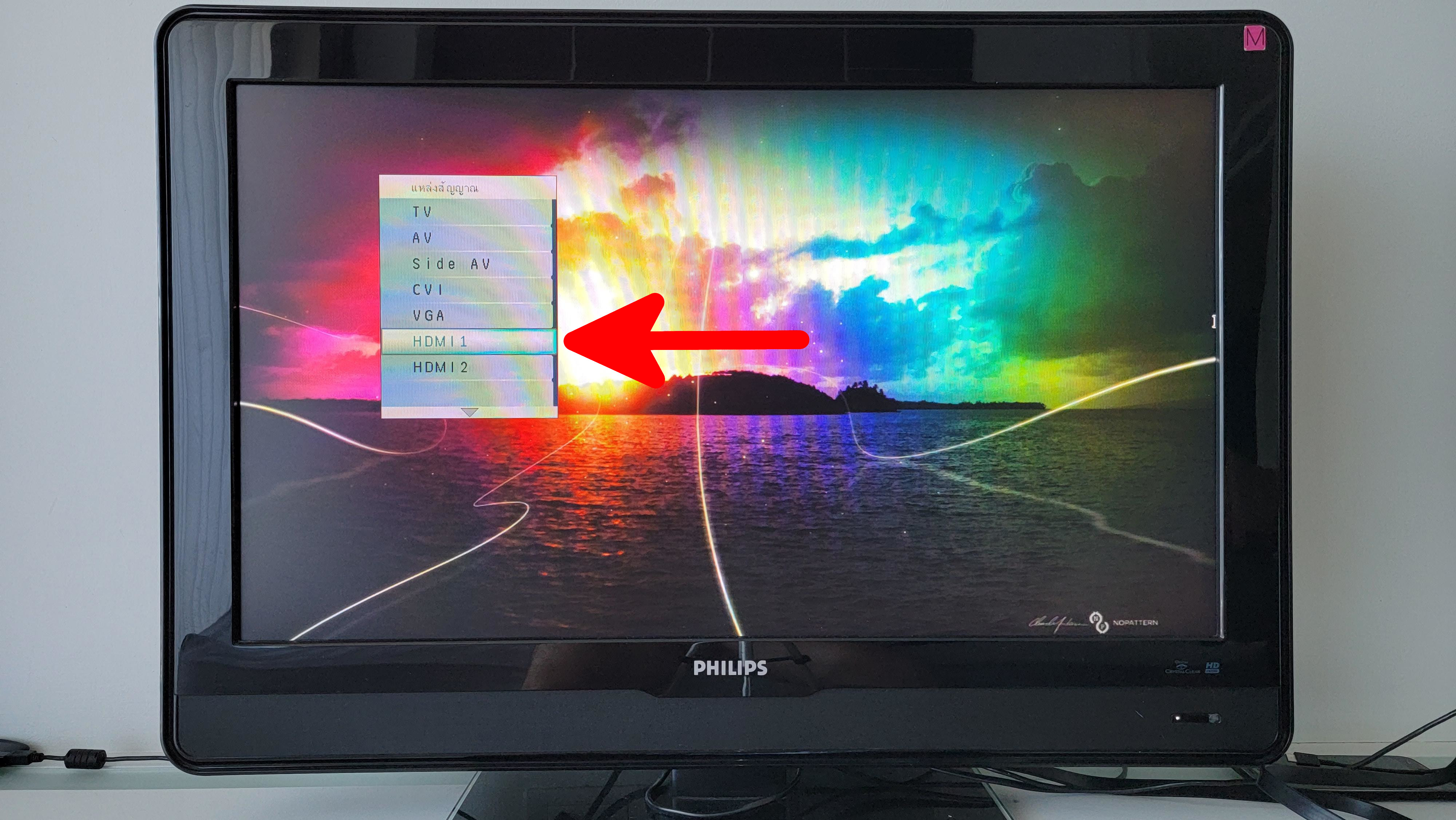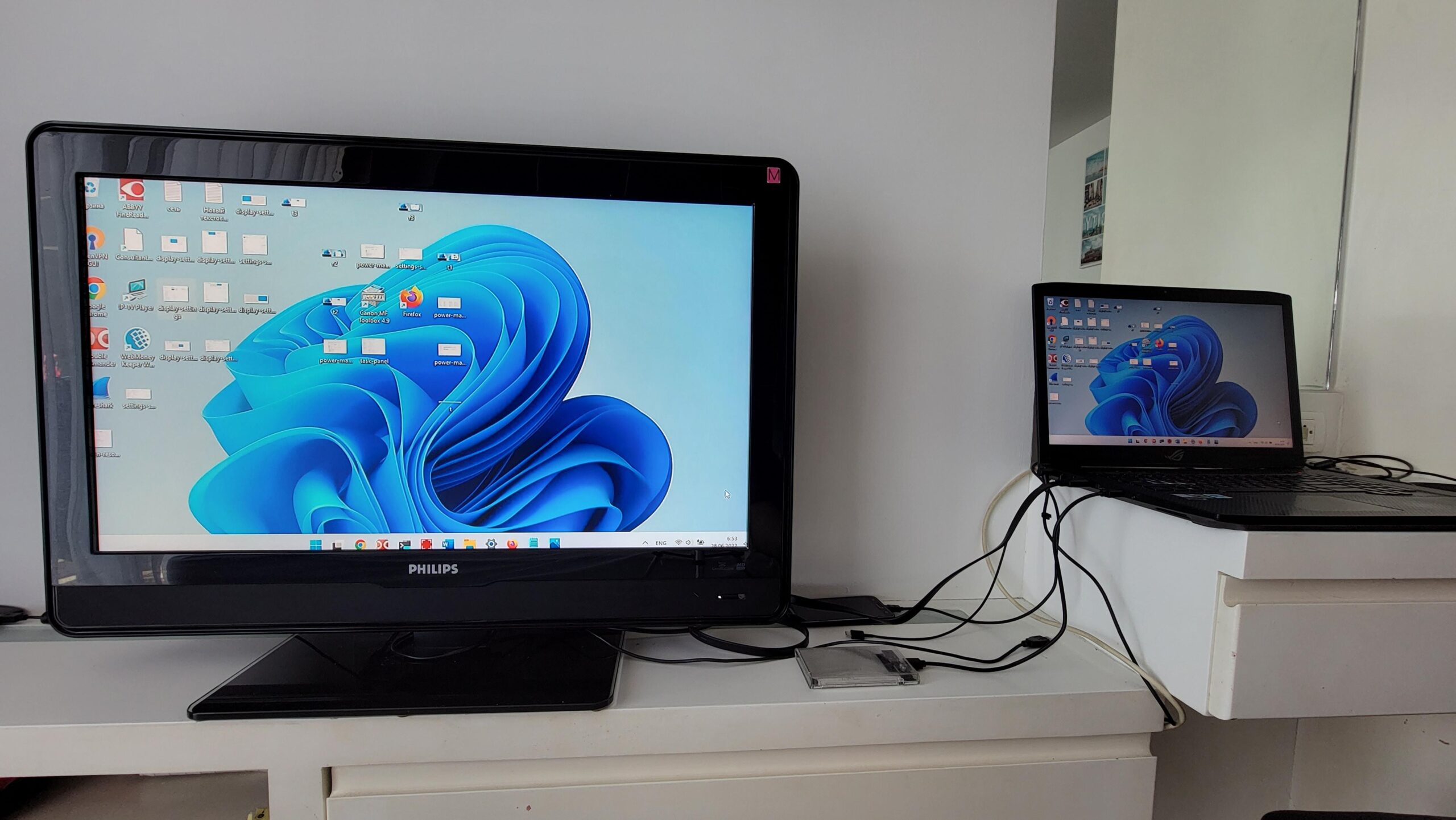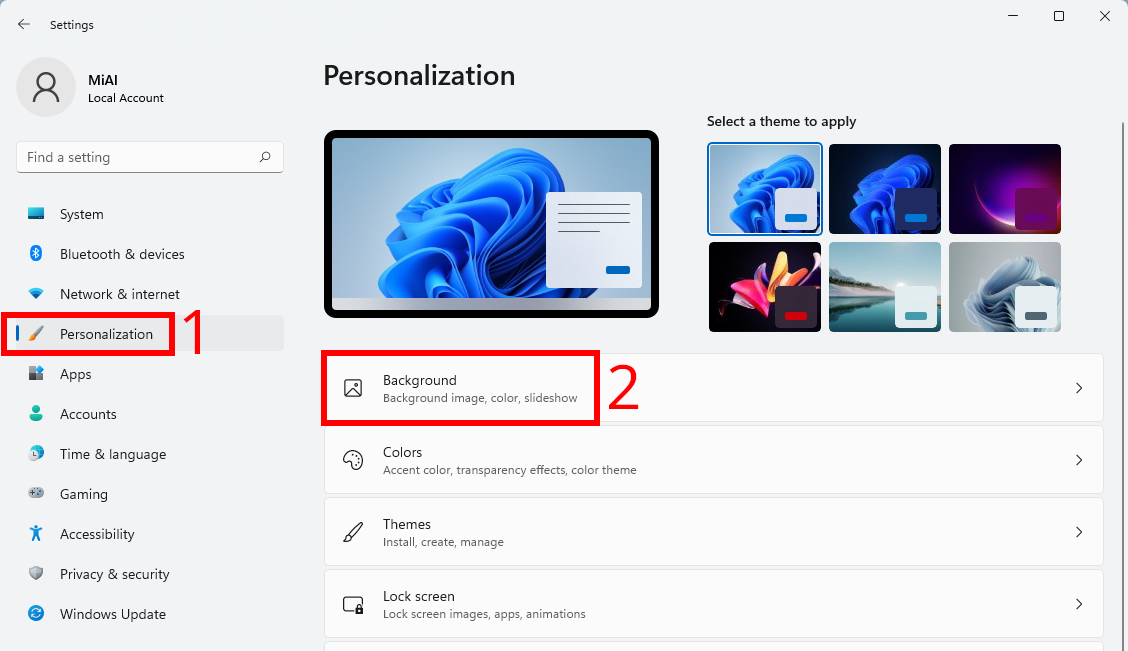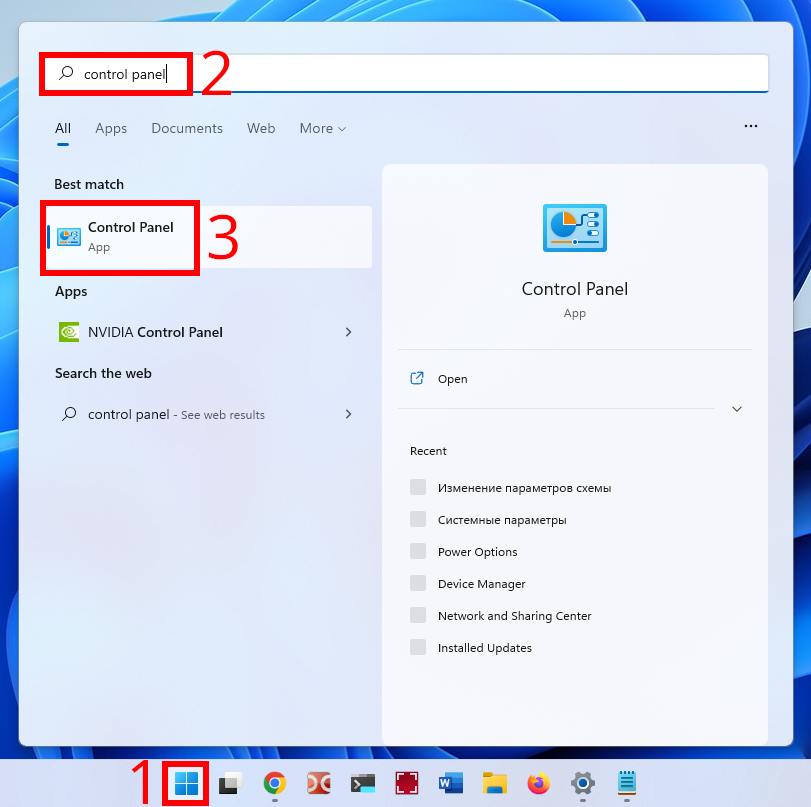
How to connect a TV to a computer in Windows 11
June 30, 2022
Is it possible to connect a TV or a second monitor to a computer in Linux
This guide will show you how to connect a TV or a second monitor to a computer in Windows 11. It will also talk about the available settings and solutions to common problems that arise when connecting a TV to a computer.
If you are a Linux user, then see the articles:
- How to connect a TV to a computer in Linux in Cinnamon (Linux Mint, LMDE)
- How to connect a TV to a computer in Linux in Xfce (Kali Linux, Xubuntu)
- How to connect a TV to a computer in Linux in GNOME (Ubuntu)
What you need to connect a TV or an additional monitor to a computer
To connect a TV or a second monitor to a computer or laptop, you need:
- TV with HDMI connector (all modern models) or monitor with HDMI connector (all monitors released in the last two decades)
- a computer with an HDMI connector – almost all computers and laptops will fit
- HDMI cable
Choosing an HDMI cable
I approached the choice of HDMI cable quite simply – I chose the cheapest with the right length, which I found in the store. In subsequent use, this cable fully satisfied my needs.
Despite its cheapness, this HDMI cable supports:
- UHD 4K@2160P / 4K@60Hz / 4K HDR
- High Speed HDMI 2.0
- Gold plated contacts
Cable length 1.8 meters.
Apparently, these are already the minimum characteristics – perhaps more expensive models support higher resolutions and data transfer at higher speeds.
What TV can be connected to a computer
Using an HDMI cable, you can connect any TV with an HDMI connector. This connector is present on all TVs and monitors released in the last decade.
Older TVs without an HDMI connector can also be connected to a computer, but instead of an HDMI cable, you will need a wire with an adapter.
As for the technical characteristics of the TV (diagonal size, screen resolution, screen refresh rate, aspect ratio), this is not critical. That is, you do not have to select a TV model with the same characteristics as your monitor. Modern video cards support a variety of modes (screen resolutions and refresh rates), including the video card will work with a TV if the screen resolution is different from the monitor.
For example, the characteristics of my devices:
- laptop monitor: 17", 1920×1080, 16:9, 120 Hz
- TV (all specifications): 32", 1366x768p, 16:10, 60Hz
That is, these are two very different devices, but at the same time I had no problems when they worked together.
How to connect HDMI cable to TV
Plug the HDMI cable into the connectors of the computer (laptop) and TV.
Both on the computer and on the TV, there may be several HDMI connectors – remember the number of the selected connector.
Turn on your computer and TV.
Note: The HDMI cable can be connected when the computer and TV are already on.
Use the remote control to select “HDMI” as the input source on the TV.
If, after selecting HDMI as the signal source on the TV, you see the message “No Input Signal”, then:
- Select HDMI with a different number.
- Move the wire, it may not be firmly connected to the computer or TV socket.
- Make sure your computer is on.
- The monitor on the computer should not be turned off due to inactivity.
How to use a TV connected to a computer
There are two main modes:
- join displays
- mirror (duplication) of images on both displays
When displays are combined, the total space expands. That is, if you connected another 1920×1080 display to a computer with one 1920×1080 display, then now the resolution of your virtual screen becomes 3840×1080, if there are three such displays, the resolution will become 5760×1080. You can drag program windows from one display to another. Some apps and games support these wide virtual screens.
When the image is repeated (Mirror), the same image will be shown on both displays.
Among the displays, Primary stands out. This is the one connected first. A feature of the main display is that it shows desktop shortcuts, although this can be changed in the settings.
In the next video, the TV is connected to the computer. To play a YouTube video on a TV, the web browser window is dragged from the monitor to the TV.
Where are the settings for the second display and TV
Open the “Settings” app by pressing Win+i.
Go to the “Display” section.
Here you will see the display settings.
Select the display (or TV) you want to customize.
At the top of the settings window, you'll see a display layout.
The “Multiple displays” settings area appears only if multiple monitors (TVs) are connected to the computer, it contains settings for the computer's behavior when working with multiple displays. To see these settings, click on the arrow icon on the right side.
The following are settings common to all displays.
Then at the bottom of the window are settings specific to each display.
Select a monitor to change its settings.
The following settings are individual for each monitor:
- Scale
- Display resolution
- Display orientation
When you go to the “Advanced display” settings section, you will also be able to adjust the refresh rate for each of the displays.
How to set Main (Primary) Monitor
By default, desktop shortcuts are shown on the Main Display. You can change, i.e. choose a new primary monitor. For this:
1. Open the “Settings” application, this can be done by pressing Win+i.
2. Go to the “Display” section.
3. Select the display you want to make Primary.
4. Expand the “Multiple displays” settings area.
5. Check the “Make this my main display” checkbox.
How to turn off the display or TV in the settings, without physically disconnecting
You can disconnect the HDMI cable from your TV or computer at any time, but this is not always convenient. In addition, you may want to turn off the computer monitor or the laptop's built-in monitor.
To turn off any monitor or TV in Settings, open the “Settings” app by pressing Win+i.
Go to the “Display” section.
Below the monitor layout, you will see a drop-down list of the following items:
- Duplicate these displays
- Extend these displays
- Show only on 1
- Show only on 2
Selecting the “Show only on…” option will cause the image to be displayed on only one display (or TV), and all others will be disabled.
A disabled monitor will stop working (it will no longer receive an input signal), but the disabled monitor will still be available in the settings. You can turn it back on at any time. To enable all monitors, select one of the following options from the drop-down list above:
- Duplicate these displays
- Extend these displays
How to make the TV show the same thing as the monitor
Open the “Settings” app by pressing Win+i.
Go to the “Display” section.
Under the monitor layout, select “Duplicate these displays” from the drop-down list.
As a result, the resulting settings for both monitors at once will be shown.
Now the image on the monitor and TV is the same:
You may notice that the picture on the TV is slightly cropped.
This may be due to the aspect ratio or screen resolution.
In my case, both the aspect ratio and the screen resolution of the monitor built into the laptop and the TV are different. Changing the screen resolution to what the TV has somewhat reduced the problem with cut edges.
How to make the TV become an extension of the monitor
Open the “Settings” app by pressing Win+i.
Go to the “Display” section.
Under the monitor layout, select “Extend these displays” from the drop-down list.
In this case, one of the monitors will be considered the main one. In this case, each of the monitors will show its own desktop, which, in fact, is one.
Why can't I drag the program window to the second screen
If you see two displays in the settings, but you can’t drag the program window to the TV or the second display, then try dragging the window to the other side. That is, if you, for example, are trying to drag a program window to the left side, then try dragging it to the right side instead.
The fact is that the physical location of the second monitor (TV) and its location in the settings can be different. To fix this, swap the monitors in the settings.
In addition to the location of the monitors to the left and right of each other, other options are possible.
You can place one of the monitors (or TVs) above the other.
In this case, the screen resolution and desktop area will change accordingly.
If you have many monitors, you can place them however you want, not all monitors need to be in a straight line horizontally. You can arrange them, for example, as 3×2, that is, two rows of three monitors.
How to make the Taskbar only show on the Main monitor
If you want the taskbar to be shown only on the Main monitor, then follow the steps below.
Open the “Settings” app by pressing Win+i.
Go to “Personalization” → “Taskbar”.
Expand the “Taskbar behavior” section.
Uncheck the “Show my taskbar on all displays” setting.
How to make the taskbar show on all monitors
If you want the taskbar to be shown on all connected monitors and TVs, then follow these steps.
Open the “Settings” app by pressing Win+i.
Go to “Personalization” → “Taskbar”.
Expand the “Taskbar behavior” section.
Check the box next to “Show my taskbar on all displays”.
After that, the Taskbar will be shown on all monitors.
How to set different desktop wallpapers for monitor and TV
You can set a different desktop wallpaper for all connected monitors and TVs.
To do this, open the “Settings” application, this can be done by pressing Win+i.
Go to “Personalization” → “Background”.
Right click on the photo you want to set as your desktop wallpaper. From the pop-up menu, select the number of the monitor for which you want to set this desktop background.
Now the desktop wallpaper on the monitor and TV is different.
How to identify displays
If you have multiple monitors and you are confused about their settings, then you can enable the display of the number on the screen of each monitor.
Open the “Settings” app by pressing Win+i.
Go to the “Display” section.
Click the “Identify” button, which is located under the schematic image of the monitors.
After that, each monitor and TV will show squares with display numbers in the settings.
Why is the sound played through a computer (laptop) and not through a TV
An HDMI cable can carry both video and audio. But even after connecting the TV with an HDMI cable, sound is still output from the laptop speakers or computer speakers.
To change the audio output source, go to the audio settings. To do this, open the “Settings” application, this can be done by pressing Win+i.
Go to the “Sound” section.
In the “Output” section, select “Audio for Displays”.
You can also expand the settings for each sound source by clicking the arrow symbol to the right of the source name. In the window that opens, you can fine-tune each sound source.
Why did the sound disappear after turning off the TV on the laptop (computer)
To change the audio output source, go to the audio settings. To do this, open the “Settings” application, this can be done by pressing Win+i.
Go to the “Sound” section.
In the “Output” section, select “Speakers”.
Setting the action when closing the laptop lid when using a second monitor
If you are using a laptop, closing the laptop lid when additional monitors are connected to it may not be what you expect. For example, when you close the laptop lid, the computer goes into Sleep mode or shuts down, but you expect to be able to work on a second monitor or watch TV connected to the computer.
To control how the computer behaves when the laptop lid is closed, open the “Control Panel”.
In the Control Panel, go to “Category” → “Small icons”.
Open the “Power Options” section.
Click on the “Choose what closing the lid does” link.
You can also go to this setting by running the command:
control /name Microsoft.PowerOptions /page pageGlobalSettings
In the window that opens, note that all actions are configured for two modes:
- On battery
- Plugged in
For the action for “When I close the lid”, select “Do nothing”.
How to prevent the monitor from turning off
If there is no activity for some time (for example, 10 minutes), the monitors will be turned off. You can disable the setting to turn off displays.
To control when monitors turn off due to inactivity, open the “Control Panel”.
In the “Control Panel”, go to “Category” → “Small icons”.
Open the “Power Options” section.
Click on the “Choose when to turn off the display” (or “Change when the computer sleeps” link).
You can also go to this setting by running the command:
control /name Microsoft.PowerOptions /page pagePlanSettings
In the window that opens, note that all actions are configured for two modes:
- On battery
- Plugged in
Set longer time intervals before turning off the monitor and entering sleep mode, or select “Never”.
Related articles:
- Is HDMI or DisplayPort better for the ultimate picture, sound, HDR, FreeSync, G-Sync and more (70.7%)
- The complete guide to HDR: how to enable, how to set up, how to watch HDR movies and YouTube, troubleshooting HDR problems in Windows (70.7%)
- How to watch IPTV on your phone (70.1%)
- What you need to pay attention to when buying a TV (monitor) for HDR (65.9%)
- How to check Bluetooth version in Windows (63.3%)
- How to convert .webp images to GIMP (RANDOM - 54.8%)







































